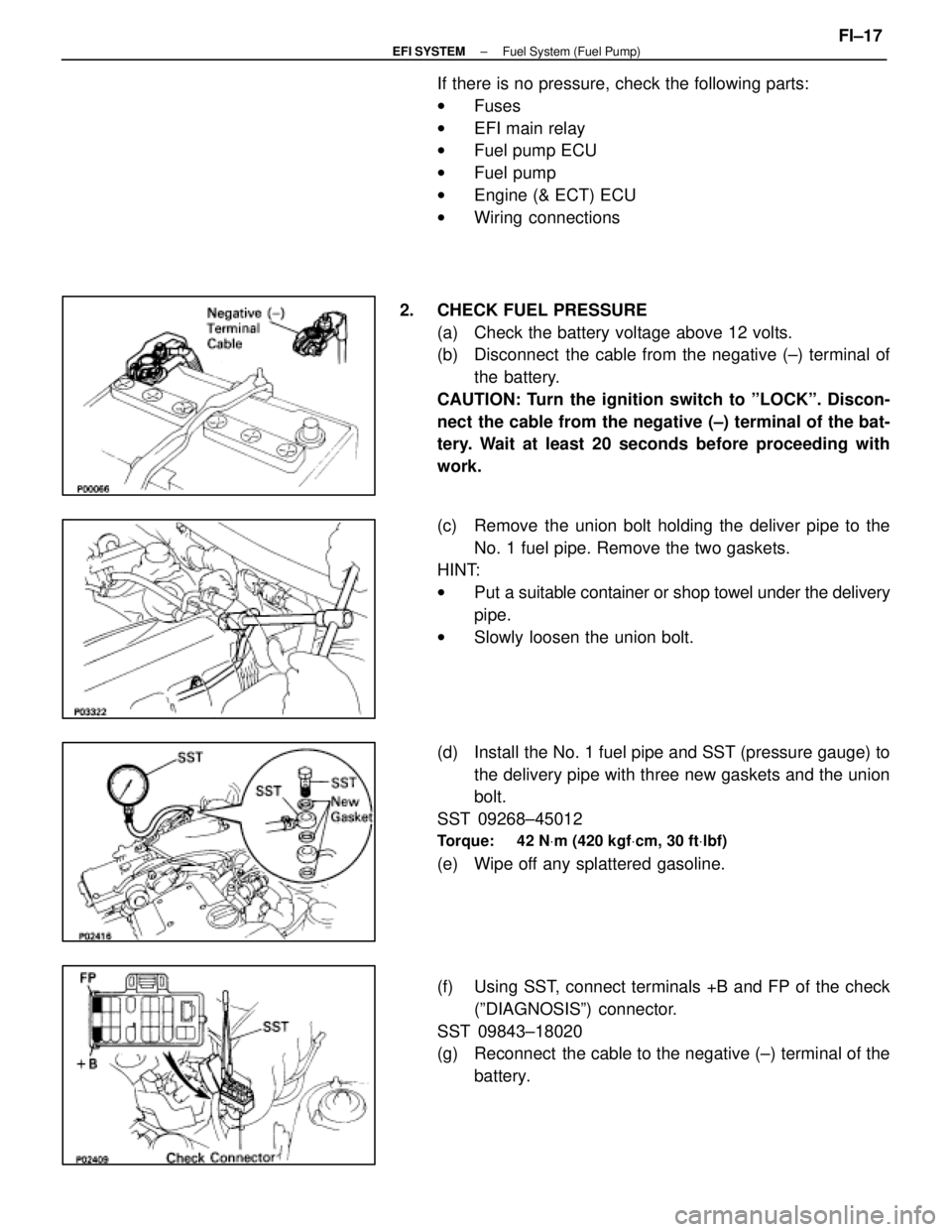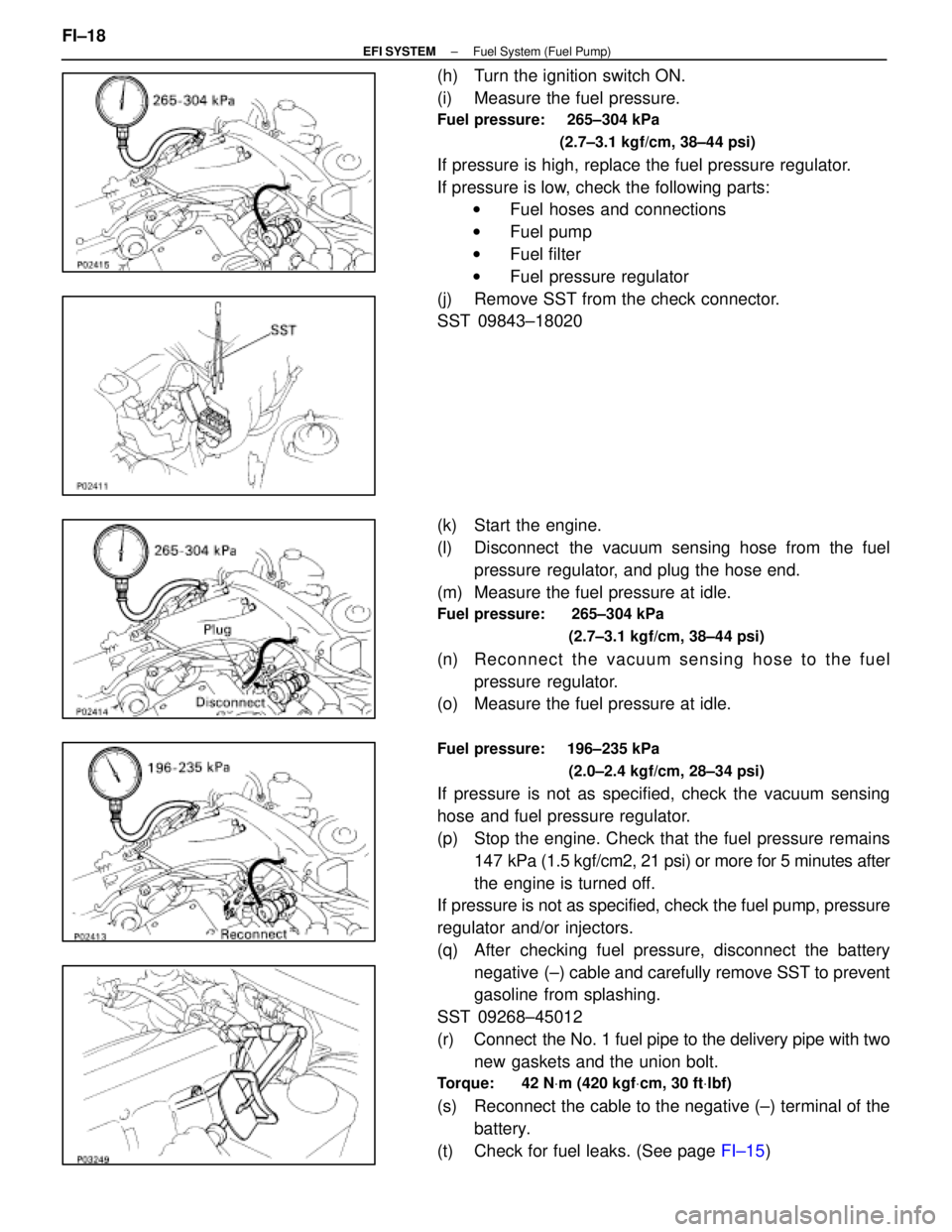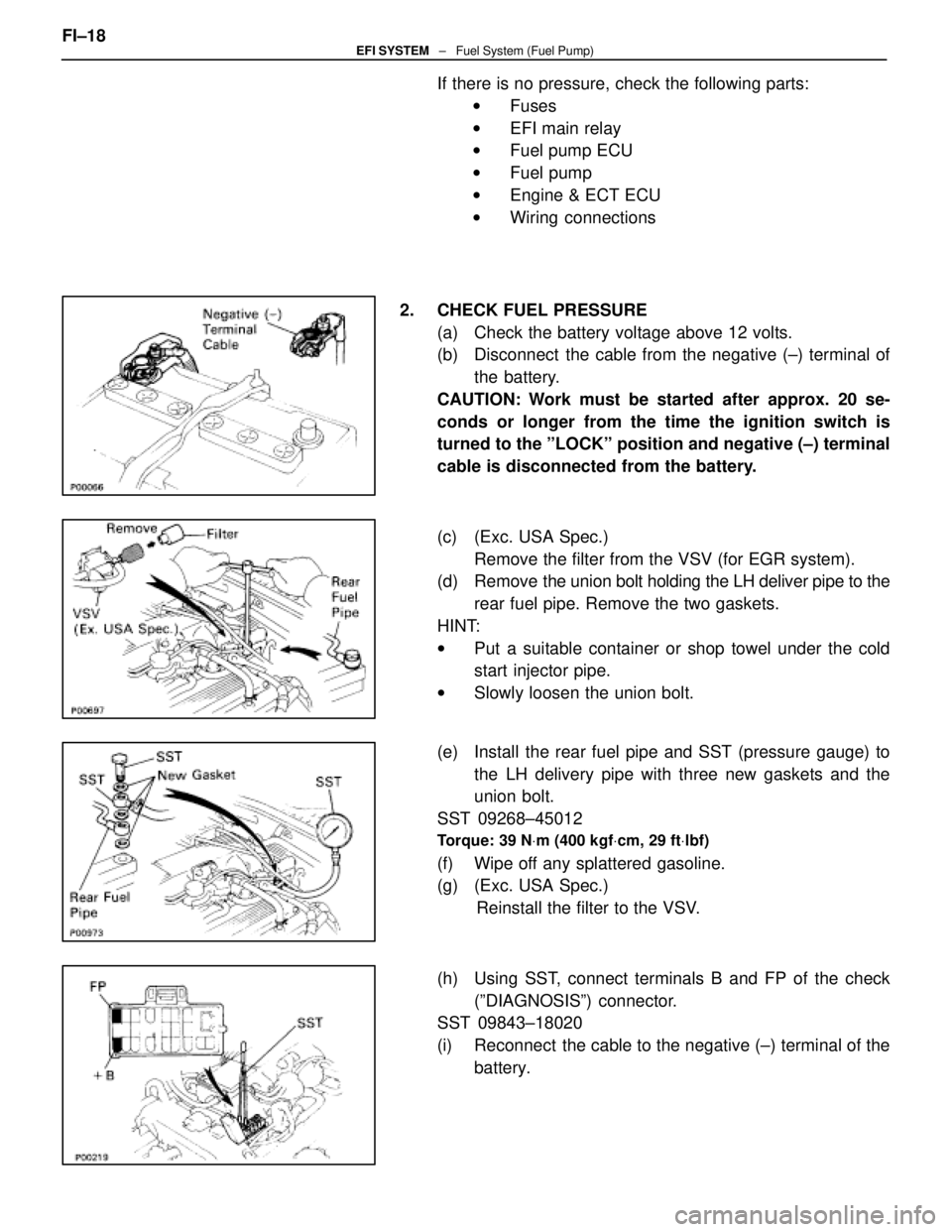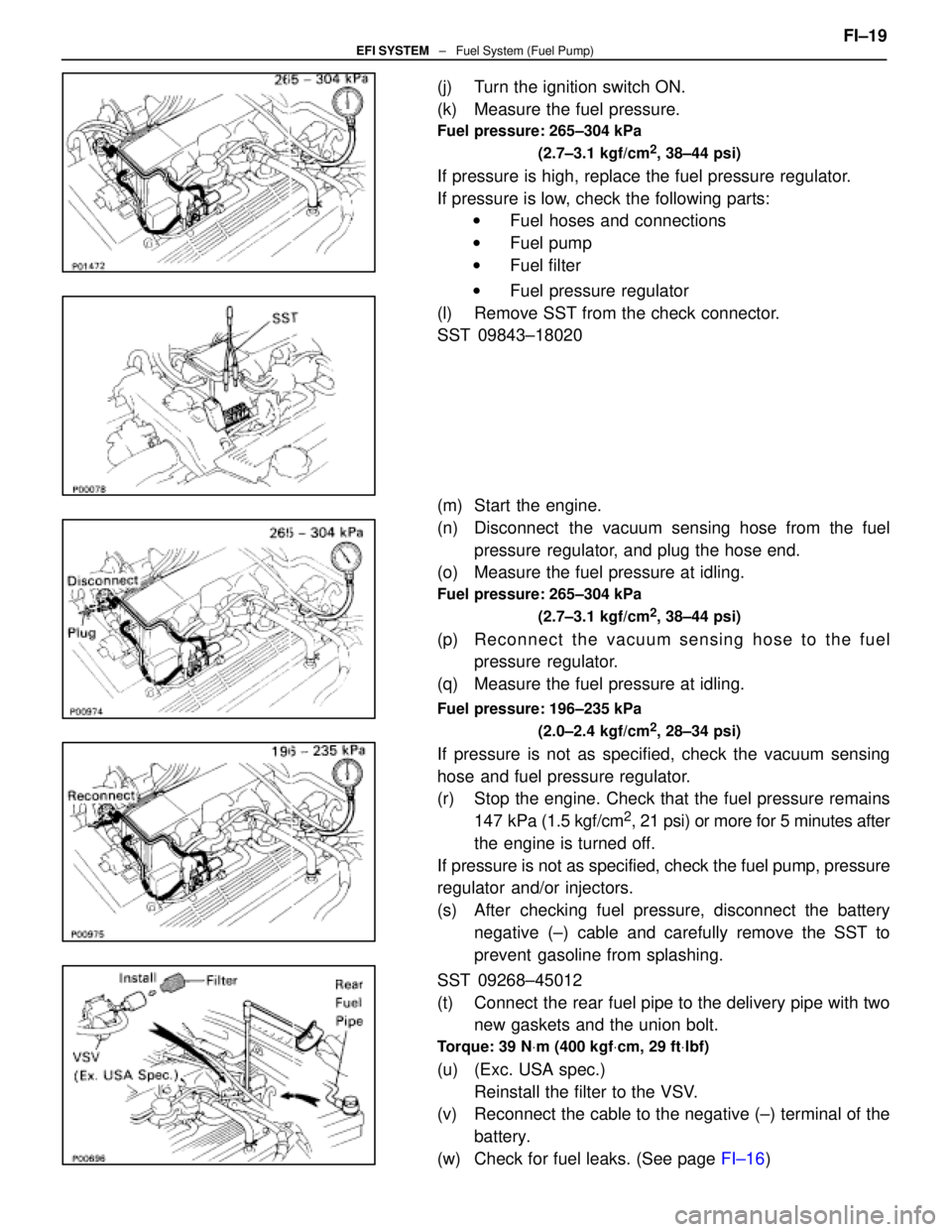Page 2029 of 4087

If there is no pressure, check the following parts:
wFuses
w EFI main relay
w Fuel pump ECU
w Fuel pump
w Engine (& ECT) ECU
w Wiring connections
2. CHECK FUEL PRESSURE (a) Check the battery voltage above 12 volts.
(b) Disconnect the cable from the negative (±) terminal ofthe battery.
CAUTION: Turn the ignition switch to ºLOCKº. Discon-
nect the cable from the negative (±) terminal of the bat-
tery. Wait at least 20 seconds before proceeding with
work.
(c) Remove the union bolt holding the deliver pipe to the No. 1 fuel pipe. Remove the two gaskets.
HINT:
w Put a suitable container or shop towel under the delivery
pipe.
w Slowly loosen the union bolt.
(d) Install the No. 1 fuel pipe and SST (pressure gauge) to the delivery pipe with three new gaskets and the union
bolt.
SST 09268±45012
Torque: 42 N Vm (420 kgf Vcm, 30 ft Vlbf)
(e) Wipe off any splattered gasoline.
(f) Using SST, connect terminals +B and FP of the check
(ºDIAGNOSISº) connector.
SST 09843±18020
(g) Reconnect the cable to the negative (±) terminal of the battery.
±
EFI SYSTEM Fuel System (Fuel Pump)FI±17
WhereEverybodyKnowsYourName
Page 2030 of 4087

(h) Turn the ignition switch ON.
(i) Measure the fuel pressure.
Fuel pressure: 265±304 kPa (2.7±3.1 kgf/cm, 38±44 psi)
If pressure is high, replace the fuel pressure regulator.
If pressure is low, check the following parts:w Fuel hoses and connections
w Fuel pump
w Fuel filter
w Fuel pressure regulator
(j) Remove SST from the check connector.
SST 09843±18020
(k) Start the engine.
(l) Disconnect the vacuum sensing hose from the fuel pressure regulator, and plug the hose end.
(m) Measure the fuel pressure at idle.
Fuel pressure: 265±304 kPa
(2.7±3.1 kgf/cm, 38±44 psi)
(n) Re c onnect the vacuum sensing hose to the fuel
pressure regulator.
(o) Measure the fuel pressure at idle.
Fuel pressure: 196±235 kPa
(2.0±2.4 kgf/cm, 28±34 psi)
If pressure is not as specified, check the vacuum sensing
hose and fuel pressure regulator.
(p) Stop the engine. Check that the fuel pressure remains147 kPa (1.5 kgf/cm2, 21 psi) or more for 5 minutes after
the engine is turned off.
If pressure is not as specified, check the fuel pump, pressure
regulator and/or injectors.
(q) After checking fuel pressure, disconnect the battery
negative (±) cable and carefully remove SST to prevent
gasoline from splashing.
SST 09268±45012
(r) Connect the No. 1 fuel pipe to the delivery pipe with two new gaskets and the union bolt.
Torque: 42 N Vm (420 kgf Vcm, 30 ft Vlbf)
(s) Reconnect the cable to the negative (±) terminal of the
battery.
(t) Check for fuel leaks. (See page FI±15)
FI±18
±
EFI SYSTEM Fuel System (Fuel Pump)
WhereEverybodyKnowsYourName
Page 2036 of 4087
FUEL SYSTEM
Fuel Pump
ON±VEHICLE INSPECTION
1. CHECK FUEL PUMP OPERATION(a) Using SST, connect terminals +B and FP of the check
(ºDIAGNOSISº) connector.
SST 09843±18020
(b) Turn the ignition switch ON.
NOTICE: Do not start the engine.
(c) Check that there is pressure in the fuel inlet hose from the fuel filter.
HINT: At this time, you will hear fuel return noise.
(d) Turn the ignition switch OFF.
(e) Remove SST from the check connector.
SST 09843±18020 FI±17
± Fuel System (Fuel Pump)EFI SYSTEM
WhereEverybodyKnowsYourName
Page 2037 of 4087

If there is no pressure, check the following parts:w Fuses
w EFI main relay
w Fuel pump ECU
w Fuel pump
w Engine & ECT ECU
w Wiring connections
2. CHECK FUEL PRESSURE (a) Check the battery voltage above 12 volts.
(b) Disconnect the cable from the negative (±) terminal ofthe battery.
CAUTION: Work must be started after approx. 20 se-
conds or longer from the time the ignition switch is
turned to the ºLOCKº position and negative (±) terminal
cable is disconnected from the battery.
(c) (Exc. USA Spec.) Remove the filter from the VSV (for EGR system).
(d) Remove the union bolt holding the LH deliver pipe to the
rear fuel pipe. Remove the two gaskets.
HINT:
w Put a suitable container or shop towel under the cold
start injector pipe.
w Slowly loosen the union bolt.
(e) Install the rear fuel pipe and SST (pressure gauge) to the LH delivery pipe with three new gaskets and the
union bolt.
SST 09268±45012
Torque: 39 N Vm (400 kgf Vcm, 29 ft Vlbf)
(f) Wipe off any splattered gasoline.
(g) (Exc. USA Spec.)
Reinstall the filter to the VSV.
(h) Using SST, connect terminals B and FP of the check (ºDIAGNOSISº) connector.
SST 09843±18020
(i) Reconnect the cable to the negative (±) terminal of the
battery.
FI±18
EFI SYSTEM
± Fuel System (Fuel Pump)
WhereEverybodyKnowsYourName
Page 2038 of 4087

(j) Turn the ignition switch ON.
(k) Measure the fuel pressure.
Fuel pressure: 265±304 kPa(2.7±3.1 kgf/cm
2, 38±44 psi)
If pressure is high, replace the fuel pressure regulator.
If pressure is low, check the following parts:w Fuel hoses and connections
w Fuel pump
w Fuel filter
w Fuel pressure regulator
(l) Remove SST from the check connector.
SST 09843±18020
(m) Start the engine.
(n) Disconnect the vacuum sensing hose from the fuel pressure regulator, and plug the hose end.
(o) Measure the fuel pressure at idling.
Fuel pressure: 265±304 kPa
(2.7±3.1 kgf/cm
2, 38±44 psi)
(p) Re connect the vacuum sensing hose to the fuel
pressure regulator.
(q) Measure the fuel pressure at idling.
Fuel pressure: 196±235 kPa
(2.0±2.4 kgf/cm
2, 28±34 psi)
If pressure is not as specified, check the vacuum sensing
hose and fuel pressure regulator.
(r) Stop the engine. Check that the fuel pressure remains147 kPa (1.5 kgf/cm
2, 21 psi) or more for 5 minutes after
the engine is turned off.
If pressure is not as specified, check the fuel pump, pressure
regulator and/or injectors.
(s) After checking fuel pressure, disconnect the battery negative (±) cable and carefully remove the SST to
prevent gasoline from splashing.
SST 09268±45012
(t) Connect the rear fuel pipe to the delivery pipe with two new gaskets and the union bolt.
Torque: 39 N Vm (400 kgf Vcm, 29 ft Vlbf)
(u) (Exc. USA spec.)
Reinstall the filter to the VSV.
(v) Reconnect the cable to the negative (±) terminal of the
battery.
(w) Check for fuel leaks. (See page FI±16) FI±19
EFI SYSTEM
± Fuel System (Fuel Pump)
WhereEverybodyKnowsYourName
Page 2044 of 4087
Fuel Pressure Regulator
ON±VEHICLE INSPECTION
CHECK FUEL PRESSURE (See page FI±17)
COMPONENTS FOR REMOVAL AND
INSTALLATION
REMOVAL OF FUEL PRESSURE
REGULATOR
1. DISCONNECT VACUUM SENSING HOSE FROM FUEL
PRESSURE REGULATOR
2. DISCONNECT NO. 2 FUEL PIPE FROM FUEL PRESSURE
REGULATOR
Remove the union bolt and two gasket, and disconnect the
fuel pipe from the pressure regulator.
HINT:
w Put a suitable container or shop towel under the
pressure regulator.
w Slowly loosen the union bolt.
3. REMOVE FUEL PRESSURE REGULATOR (a) Remove the two bolts and pressure regulator.
(b) Remove the O±ring from the pressure regulator.
FI±24
±
EFI SYSTEM Fuel System (Fuel Pressure Regulator)
WhereEverybodyKnowsYourName
Page 2045 of 4087
INSTALLATION OF FUEL PRESSURE
REGULATOR
(See components on page FI±24)
1. INSTALL FUEL PRESSURE REGULATOR AND FUEL RETURN PIPE
(a) Apply a light coat of gasoline to a new O±ring, and install
it to the pressure regulator.
(b) Install the pressure regulator with the two bolts.
Torque: 8.8 N Vm (90 kgf Vcm, 78 in. Vlbf)
2. CONNECT NO. 2 FUEL PIPE TO FUEL PRESSURE
REGULATOR
Connect the fuel pipe to the pressure regulator with new two
gaskets and the union bolt.
Torque: 27 N Vm (280 kgf Vcm, 20 ft Vlbf)
3. CONNECT VACUUM SENSING HOSE TO FUEL
PRESSURE REGULATOR
4. CHECK FOR FUEL LEAKS (See page FI±15)
±
EFI SYSTEM Fuel System (Fuel Pressure Regulator)FI±25
WhereEverybodyKnowsYourName
Page 2051 of 4087
(2) Water by±pass hose from ISC valve
(3) (USA Spec.)Vacuum hose
(4) (Exc. USA Spec.) Three vacuum hoses
(c) Remove the two bolts and two nuts, disconnect the throttle body from the air intake chamber.
(d) Disconnect the following hoses, and remove the throttle body:
(1) PCV hose from throttle body
(2) Water by±pass hose from throttle body
(e) Remove the throttle body gasket.
14. DISCONNECT CONNECTORS Disconnect the following connectors:w Cold start injector connector
w ISC valve connector
w (USA Spec.)
EGR valve connector for EGR system
w (Exc. USA Spec.)
VSV connector for EGR
w VSV connector for fuel pressure control system
FI±30
EFI SYSTEM
± Fuel System (Cold Start Injector)
WhereEverybodyKnowsYourName